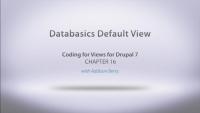In this lesson, we’ll take a look at how to modify the HTML output from Views, explore some of the default templates that Views provides, and learn about the various permutations of names we can give our template files to override output for everything from a large set of Views to a single field on a single View. We’ll also discuss the difference between displays, styles, rows, and fields when it comes to theming a View.
There's a reason views is the most popular module on drupal.org and it's pointy-clickly user interface is only a part of that. In this series we cover the ins and outs of writing modules that implement the Views API. Once you’ve realized the power of creating complex lists of nodes, users and other content via the views UI the next logical desire is to allow people to do that with the content provided by your custom module as well. This series will take an in-depth look at exposing your own database tables to the Views module so that users can use them as a place to pull content from including the fields themselves and meta-data about how they can be used to create relationships to other content on your site.
After getting the basics out of the way we’ll also take a look at writing our own custom field handlers to expose our module’s data to views so that it can be sorted, filtered, and queried in new ways. We’ll also look at implementing views plugins to do things like add custom access control options to views and to add new output styles.
Once you understand a bit more about how views works under the hood and how easy it is to tie in to that system you’ll be reimaging your solutions for all sorts of different problems.
PHP
TopicPHP: Hypertext Preprocessor (PHP) is a popular interpreted programming language that is especially suited for web development. Drupal core and all contributed modules are written in PHP.
To get things started, in this lesson we'll create a new module, and use hook_views_api() to let Views know we want to use its API.
Taxonomy
TopicTaxonomy in Drupal provides a way to classify your site’s content. Taxonomy vocabularies are created with terms within those vocabularies.
In this lesson, we pull our work together by creating a new view on the site that uses the work we've done so far with exposing our data, and creating our handlers. Once we create the view, we'll export it and add it to our module as a default view.
Standardized documentation is crucial to a project, whether it is just you or an entire team working on it. In this tutorial we're going to look at:
- Standards for
@docblockcomments - Standards for inline comments
- Why standards for documentation and comments are as important as standards for the rest of your code.
By the end of this tutorial you'll know how to add inline documentation for all the PHP code that you write for Drupal.
Forms (Form API)
TopicDrupal provides a standard, secured method for module developers to add forms to a Drupal website. Learn how to use the Form API to build, validate, and submit a custom form.



